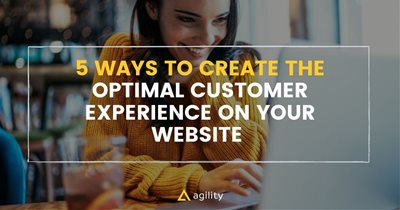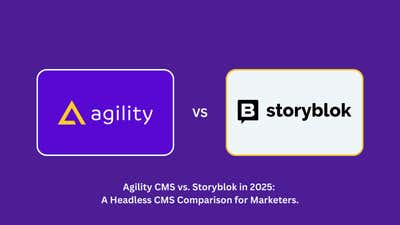5 Ways to Create the Optimal Customer Experience on Your Website
A Short Guide to CX 2021


With retail activity mostly budding on virtual stores rather than physical ones, businesses are becoming increasingly concerned about the virtual experience they provide.
If you happen to be amongst these worried individuals as well, then this post may as well be just for you! Here we discuss the top 5 ways of creating an optimal customer experience on your website. And, consequently, retaining your customers on your page wholly and solely.
Opt for Reputable Host Providers
Did you know that 40% of consumers abandon a website when it takes more than 3-seconds to load? Well, this means the load speed plays a crucial role in making your customer’s experience pleasant on your website.
So, how can you ensure the load speed of your webpage is that it's best? You can do so by opting for the best, well-known hosting platforms.
(Quick Note: Hosting and domain are two different things! The domain is the website name, whereas the hosting is the place in the virtual world where your website is stored.)
There are various hosting service providers in the market today. You will find some with sky-rocketing charges and some that come free. While many website owners opt for the free version, what they do not realize is that these hosting perform poorly.
When purchasing a hosting service, conduct research and choose the platforms that offer good features at reasonable rates. Again, do not fall for free host providers, nor do go for extremely expensive ones.
Some modern hosting services include Netlify and Vercel which allow you to host blazing-fast website for pretty much free.
Learn more why more and more websites are moving from Wordpress to Jamstack: Why you need to Migrate to JAMStack Right Now
Ensure Compatibility of Plugins
Do you use plugins and third-party apps on your website? Well, did you know the wrong or incompatible plugins on your website can make it slower?
A majority of online platforms and stores use plugins on their site to make it more versatile as well as pleasant. Plugins are one of the fundamental tools in website personalization. You will find plugins for adding frontend assets that include:
- Images
- Stylesheets
- JavaScript Files
However, each of these plugins is burdening the load on the web server. Consequently, affecting the load speed negatively. Perhaps, this is why you should always install plugins that are of utmost value and importance only. Too many plugins can be bad for your site!
Moreover, when adding more than one plugin, ensure they are compatible together. Conflict or compatibility issues between plugins can have an adverse impact on the website's performance. Apart from compatibility, keep the plugins frequently updated to avoid any security or performance concerns.
Make Use of CDNs
CDNs, an abbreviation for Content Delivery Network, are another essential factor to contribute to your website’s loading time. These CDNs reduce the time required for website content to reach the geographical location of the customer.
Usually, the content of all websites takes the web server as the route to reach an audience in various locations. As all the website content is using the same route, the load time of the website can be slower than average. Hence, ruining your customer’s experience.
Installing CDNs to your website can provide your webpage content a short-cut or dedicated route to reach the site visitor’s location quicker.
Another added benefit of CDNs is that it helps to increase the security of the website. The dedicated paths prevent attacks on the content and main web server. Thus, securing your vulnerable files and sensitive information present at the main web server.
Learn more about the benefits of CDN and how to do it: Putting your website behind a CDN like Akamai, Cloudflare or AWS Cloudfront
Keep it Mobile Friendly
Times have changed a lot where the desktop is no longer considered as the ideal regular use device. Nowadays, people use smart touchscreen devices, with mobiles being the most used ones. Tablets and convertible monitor stands, laptops are also rising in numbers.
These one-piece, lightweight gadgets are quite easy to carry anywhere you go.
Well, considering the frequency of mobile visits, Google has recently changed its algorithm where it is using a mobile-first indexing policy to rank websites. It means that websites that offer mobile versions get ranked before desktop-only ones.
Hence, when optimizing your website for the best customer experience, make sure your website is mobile-first. Mobile-first refers to website designing that features a mobile version before the desktop version.
Apart from ranking, the mobile-first websites will offer your customers a visually-pleasant browsing experience. They will be able to navigate your website better and read content easily.
Keep reading to learn more: A Guide To Optimizing Your Website For Mobile
Optimize Visual Data
Gone are the days when the site visitors enjoyed reading bulk reading texts. These days, people can grasp your message and content meaning more through visual content.
Hence, adding images, animations, and graphics can make your website more customer-friendly. It will not only engage the visitors, but also want them to return to your site again and again.
But, you should be careful with all the visual data and optimize it thoroughly. Adding bigger and heavier images and graphics can make the website's performance slower. Thus, it is essential to decrease the size as well as the footprint of the visual data.
Usually, this gets done by using PNG format for static images and JPEG format for all the others. These particular formats reduce the memory load. One can also use image compressing tools. Also, never put too much visual data on a single page. Distribute the visuals evenly and keep it minimalistic.
Check out other ways to increase online engagement: 11 Proven Methods To Improve Content Engagement For Your Business (agilitycms.com)
Switch to Headless CMS
When it comes to optimizing digital experiences and integrating more software tools into your tech stack, it can be difficult to choose the right tools for the job, but a trend of switching from Traditional to Headless CMS is here to stay.
Headless CMS Software Market was valued at US$ 328.5 million in 2019 and is projected to reach US$ 1,628.6 million by 2027; it is expected to grow at a CAGR of 22.6% from 2020 to 2027.
Since the business dynamics are changing, from customer support and production to IT infrastructure and management, everything needs to be updated. In the current situation, the traditional CMS system is unable to fulfill the needs and demands.
Contrary to a traditional CMS, a headless CMS is entirely decoupled from the presentation layer/frontend, which in this case is the “head”, and the backend is your content repository, known as the “body”. Unlike a monolithic system, headless CMS helps adapt the business to rapid change faster.
With a headless CMS, you can easily store and add content in one place. From here, the content can be used anywhere as it is connected with a RESTful API bringing the benefits of omnichannel experience and ecommerce to any business.

About the Author
Shawn Mack is a content writer passionate about technology and marketing. His educational background in business and technical field has given him a broad base from which to approach many topics around content marketing, website optimization and digital strategy.



